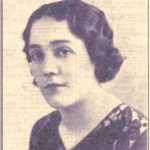Summary
Peter Seaton, aged 11 months, died in a fire on the morning of December 25, 1938. His cot was on the ground floor of a tenement house. He slept alone. His room was heated by an electric heater. At 4:20 a.m. his foster mother checked on him, and everything was alright. At about 7 a.m. the alarm was raised. Several people tried to reach Peter, but at that time the room was already a mass of flames.
The inquest was on January 3. Newspapers reported on the inquest on January 4 and 5.
The electric stove was on during all the time that Peter slept in that room. This was quite exceptional for two reasons. One was that this was not the place he usually slept. But he was a bit sick and tended to kick his clothes off (or his blanket away). The second was that the weather was bitterly cold. Peter may have been put there because of the presence of a stove, because the doctor had said that he should be kept warm.
Possibly the wiring in the house or just the connection in the wall socket could not support so much current during such a long time to that stove, even though the stove itself had no problem.
The inquest, as far as reported in the newspapers, only focused on the question: was the fire caused by any wilful incendiarism on the part of anyone? No conjectures about the cause of the fire were mentioned. Note however the quote from the Daily Telegraph mentioned at the end.
In the following the line endings of the newspaper articles are preserved.
1. The Scotsman – Tuesday 27 December 1938
page 10, column 6
CHILDREN RESCUED FROM BLAZING HOUSE
Lowered from First Floor Window
Eleven-months-old Peter Seton [sic] died in a
fire in Peckham Rye, London, from which
several other children were saved, on Christ-
mas Day. Miss Dorothy Lindsell (24), who
jumped into a blanket held by people in the
street was seriously injured, and also had
burns. A neighbour stated that a number
of babies were rescued from the house by
being lowered from a first floor window.
Two or three firemen were slightly injured.
2. Dundee Courier – Tuesday 27 December 1938
At that time the publication was titled:
The Courier and Advertiser.
Under the general heading
TRAPPED PARENTS JUMP, SAVE BABY
FIRES TAKE HEAVY TOLL
eight UK instances of fires are mentioned, one of them being
‘It is believed that he had a heart attack and collapsed while
carrying a candle.’ This person was called Stark, although
Western Daily Press gives the name as John Spark (67) and adds
that he was found ‘lying across a still unlighted fire’
The second fire is under the caption
BABY LOST
and is word for word the same as reference 1.
3. Dundee Evening Telegraph – Wednesday 04 January 1939
At that time the publication was titled:
The Evening Telegraph
page 6 column 2
12 People in
House: Baby,
Sleeping Alone,
Died in Fire
Inquest on Victims
of Blaze
An 11-month-old baby who died in a
Christmas Day fire at Peckham Rye was
sleeping alone in a house in which there
were 12 people, because he had been ill.
The foster-mother told Mr A. Douglas
Cowburn (the coroner) at the Camberwell
inquest, that she kept an electric fire alight
in the room all night because the child was
apt to kick his clothes off and the weather
was bitterly cold.
The boy, Peter Seatin, [sic] died before the
firemen could reach him, and a 24-year-old
woman, Miss Dorothy Lindsell. died in
Dulwich Hospital on December 29.
Mr Cowburn said that at 11.30 on Christ-
mas Eve there were six children in the
house, one adult who had gone to bed, and
five other persons who were playing cards,
and continued to do so until 1.45 a.m.
Peter slept alone in a room on the ground
floor. There was an electric stove in the
room, but it did not appear to be in close
proximity to the cot.
About seven o’clock on Christmas morning
an occupant sleeping on the top floor smelt
burning, and raised the alarm. Four or
five children were taken out to the street,
but Peter could not be rescued.
Dorothy Lindsell was awakened by the
screaming, and although the fire brigade
was summoned by passers-by she either
jumped or fell from the top floor window
into the basement.
Told to Keep Him Warm.
Mrs Elsie May Booth, Peter’s foster-
mother, said that he was sleeping alone
because he had been ill, and the doctor
had told her to keep him warm. At 4.20
a.m. Peter was asleep in his cot. He had
an electric fire alight in his room all night
because he was apt to kick his clothes off,
and the weather was bitterly cold. She was
positive she was not smoking when she
went into the room.
After giving the fire alarm she was told
that all the children except Peter were
safe.
“I ran to Peter’s room,” she added,
“but could not get in because the flames
beat me back. I then tried to get in
through the french windows at the back,
but it was impossible.”
Detective-Inspector Charles Hearn was
asked by the coroner —Have you found any-
thing to lead you to suppose that this fire
was the result of any wilful incendiarism on
the part of anyone in the house?
“Nothing whatever,” was the reply.
The coroner said that it was only right
to say that there was not the slightest
evidence that Mrs Booth did not treat the
children adequately and properly; indeed,
there was some evidence that she was fond
of the child.
Returning verdicts of accidental death,
the jury said that they did not wish to
add any rider comment.
4. Belfast Telegraph – Thursday 05 January 1939
page 4, column 3.
(text is almost the same as reference 3)
FIRE LEFT TO KEEP
BABY WARM.
BLAZE COST TWO LIVES.
LONDON INQUEST EVIDENCE.
An 11-month-old baby boy who died
in a Christmas Day fire at Peckham Rye
was sleeping alone in a house in which
there were 12 people because he had
been ill.
The foster-mother told Mr. A. Douglas
Cowburn (the coroner) at the Camber-
well inquest, on Tuesday, that she kept
an electric fire alight in the room all
night because the child was apt to kick
his clothes off and the weather was
bitterly cold.
The baby, Peter Seaton, died before
the firemen could reach him, and a 24-
year-old woman, Miss Dorothy Lindsell,
who either jumped or fell from a top
floor window, died in Dulwich Hospital
on December 29.
Mrs. Elsie May Booth, Peter’s foster-
mother, said that he was sleeping alone
because he had been ill, and the doctor
had told her to keep him warm. At 4-20
a.m. Peter was asleep in his cot. He had
an electric fire alight in his room all
night because he was apt to kick his
clothes off, and the weather was bitterly
cold. She was positive she was not
smoking when she went into the room.
After giving the fire alarm she was
told that all the children except Peter
were safe.
“I ran to Peters room,” she added, “but
could not get in because the flames beat
me back. I then tried to get in through
the French windows at the back, but it
was impossible.”
Det.-Inspector Charles Hearn was
asked by the Coroner—Have you found
anything to lead you to suppose that this
fire was the result of any wilful incendi-
arism on the part of anyone in the
house?
“Nothing whatever,” was the reply.
The Coroner said that it was only
right to say that there was not the
slightest evidence that Mrs. Booth did
not treat the children adequately and
properly; indeed, there was some evi-
dence that she was fond of the child.
Returning verdicts of accidental death
the jury said that they did not wish to
add any rider or comment.
5. Nottingham Journal – Wednesday 04 January 1939
At that time the publication was titled:
The Journal
page 2, column 4
CHRISTMAS DAY FIRE
DRAMA STORY
Hair Caught Alight Effort
to Save Baby
A Christmas Day fire at Peckham,
London, as a result which a young
woman and baby lost their lives, was
investigated by the Coroner at Camber-
well yesterday.
The baby, Peter Seaton, aged 11
months, died before the firemen could
reach him. The young woman, Miss
Dorothy Lindsell, aged 24, died in hos-
pital on 29 December.
Returning verdicts of accidental death,
the jury said they did not wish to add
any rider or comment.
It was stated that about seven o’clock
on Christmas morning an occupant
sleeping the top floor smelt burning
and raised the alarm.
Four or five children were taken into
the street, but Peter could not be
rescued.
Harold Edwin Huxstep, who was stay-
ing at the house, said that when the
alarm was given be rushed to Peter’s room.
“It seemed at though I had opened
a furnace door,” he said.
“There was a mass of flames. I was
flung back across the hall and my hair
caught alight. It was impossible to
get Peter out.”
Later he saw Dorothy Lindsell stand-
ing at her window screaming.
“There was a large and excited
crowd, half of which shouted to her to
stay until the fire brigade arrived, and
half told her to jump. Eventually she
jumped. She hit the edge of the
blanket held out for her and fell into
the basement.”
6. Birmingham Daily Post – Wednesday 04 January 1939
At that time the publication was titled:
The Birmingham Post
page 7, column 2
Christmas Morning Fire
“Verdicts of Accidental death” were
returned at the double inquest at Camberwell
yesterday on a twenty-four year old girl and
eleven-month-old baby, who died as the result of
a fire at a house at Beckham Bye, London, S.E.
on Christmas Day. The baby, Peter Seaton,
died before the firemen could get to him, and the
girl, Dorothy Lindsell, died in Dulwich Hospital
four days later.
Mr. A. Douglas Cowburn, the Coroner, said
that at 11.30 p.m. on Christmas Eve there were
six children and six adults in the house. Peter
slept alone in a room on the ground floor. At
about 7 a.m. on Christmas morning an occupant
sleeping on the top floor smelt burning and
raised the alarm. Four or five children were
taken out to the street, but Peter could not be
rescued. Dorothy Lindsell was awakened by the
screaming and either jumped or fell from the top
floor front window into the basement.
Mrs. Elsie May Booth, foster-mother of Peter
Seaton, said the latter was sleeping alone
because he had been ill. At 4.20 a.m. he was
asleep in his cot. When the fire broke out she
ran out with one baby and tried to reach Peter’s
room, but the flames beat her back.
Evidence was given by a child protection
officer that Mrs. Booth had always given every
care and attention to the children in her charge.
A police officer said he had made exhaustive
enquiries and found nothing to lead him to
suppose that the fire was the result of incen-
diarism on the part of anyone in the house.
7. Daily Mirror – Tuesday 27 December 1938
page 15, column 3
GIRL
LEAPS
IN FIRE
WOMEN in a crowd outside a house
ablaze in Peckham Rye, S.E., yester-
day screamed as they saw a girl appear
on a window ledge on the second floor and
prepare to jump.
The girl, Evelyn [sic] Lindsell, twenty-four, hesi-
tated for a moment. Beneath firemen held
a net outstretched.
“Right!” shouted the firemen.
Just as the girl crouched to leap she
slipped on the icy window-ledge and fell to
the pavement, missing the net by inches.
Miss Lindsell was taken to hospital with
serious leg injuries and burns.
Peter Seaton, aged eleven months, was
burned to death in his cot in the fire which
occurred in a tenement house.
Several children and Mrs. E. Booth, who were
asleep in the house, were roused by neighbours
and escaped.
8. The Leeds Mercury – Tuesday 27 December 1938
page 1, column 3
Under the captions
Christmas
Fire
Tragedies
Babies Rescued
from Window
the text is almost verbatim that of reference 1
9. Linlithgowshire Gazette – Friday 30 December 1938
page 5, column 5
Under a general caption
Christmas Fires Tragedies
there are two paragraphs as follows:
Peter Seton [sic] (11 months) died in a fire
at Peckham Rye, London, from which
several other children were saved.
Miss Dorothy Lindsell (24), who jumped
from the house into a blanket, was seri-
ously injured.
10. The Derry Journal – Wednesday 28 December 1938
page 7, column 6
Under the general caption
HOLIDAY
DEATHS FROM
FIRE
there is a paragraph with caption
BABIES RESCUED
and text and text as in reference 1.
11. Yorkshire Post and Leeds Intelligencer – Tuesday 27 December
At that time the publication was titled:
The Yorkshire Post
page 3, column 3
caption:
BABIES LOWERED FROM
WINDOW
text as in reference 1
12. Belfast News-Letter – Tuesday 27 December 1938
page 9, column 1
caption
BABIES LOWERED FROM
BURNING HOUSE
text as in reference 1
13. Bradford Observer – Tuesday 27 December 1938
At that time the publication was titled:
The Yorkshire Observer
page 7, column 2
caption:
TRAIL OF DEATH IN CHRISTMAS HOLIDAY
BABIES RESCUED FROM BLAZING HOUSE
WOMAN BADLY HURT
JUMPING INTO
BLANKET
text as in reference 1.
14. Yorkshire Evening Post – Thursday 29 December 1938
page 9, column 6
SECOND FIRE VICTIM
Miss Dorothy Lindsell (24), who was
seriously injured on a fire at Peckham Rye,
London on Christmas morning, died to-day
in Dulwich Hospital. Peter Seton [sic] (11
months) was burned to death in his cot
during the blaze.
15. Birmingham Daily Gazette – Tuesday 27 December 1938
page 4, column 1
caption:
ELEVEN DIE IN CHRISTMAS FIRES
under the subcaption
JUMPED IN BLANKET
the text is as in reference 1.
16. Halifax Evening Courier – Tuesday 27 December 1938
At that time the publication was titled:
The Halifax Daily Courier and Guardian
page 2, column 2
under the general caption
CHRISTMAS FIRES HAVOC
the first of several items is
the text of reference 1.
17. Western Morning News – Tuesday 27 December 1938
At that time the publication was titled:
The Western Morning News and Daily Gazette
page 5, column 1
under a general caption
CHRISTMAS
MORNING
EXPLOSION
the second item has caption
BABIES RESCUED
and the text is as reference 1.
18. Western Daily Press – Tuesday 27 December 1938
At that time the publication was titled:
The Western Daily Press and Daily Mirror
page 10, column 1
under the general caption
HOLIDAY
FIRES –
ELEVEN DIE
a subcaption says
BABY’S DEATH
Peter Seton, [sic] aged 11 months, died in a
fire at Peckham Rye, London, from which
several other children were saved. Miss
Dorothy Lindsell (24), who jumped from
the house into a blanket, was seriously
injured. A neighbour stated that a number
of babies were rescued from the house.
19. Daily Herald – Tuesday 27 December 1938
page 2, column 1
9 Lives
Lost
in Fires
Eleven – month – old Peter
Seton [sic] was killed in his cot when
fire broke out at a large house
in Peckham Rye, S.E.
Other children in the house were
lowered to safety from the first floor
by ambulance men, using sheets.
A woman who had worked at the house
told the “Daily Herald” that it was
occupied by several women, one of whom
was a foster mother.
The story was rendered by Eric Frank Russell, in Tomorrow, May 1942.
On p. 9 he quotes The Daily Telegraph of January 4th. 1939 (not in the above collection)
Superintendent E.H. Davies of London’s fire department, said the blaze began in the child’s room but ” there was nothing to suggest that it originated near an electric fire there.”
This, or one Russell’s reproductions of the same article, e.g. Fate, December 1950, is probably the source for Harrison (Fire from Heaven) who on p. 6-7 asserts that the fire ‘had left most of the furniture untouched’.



